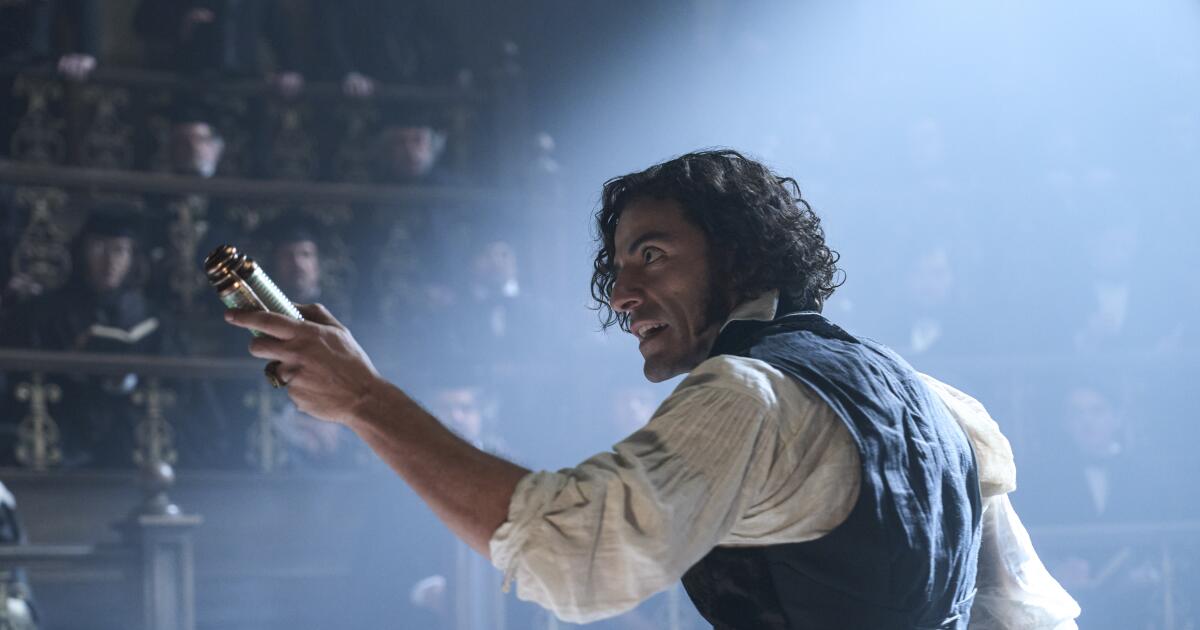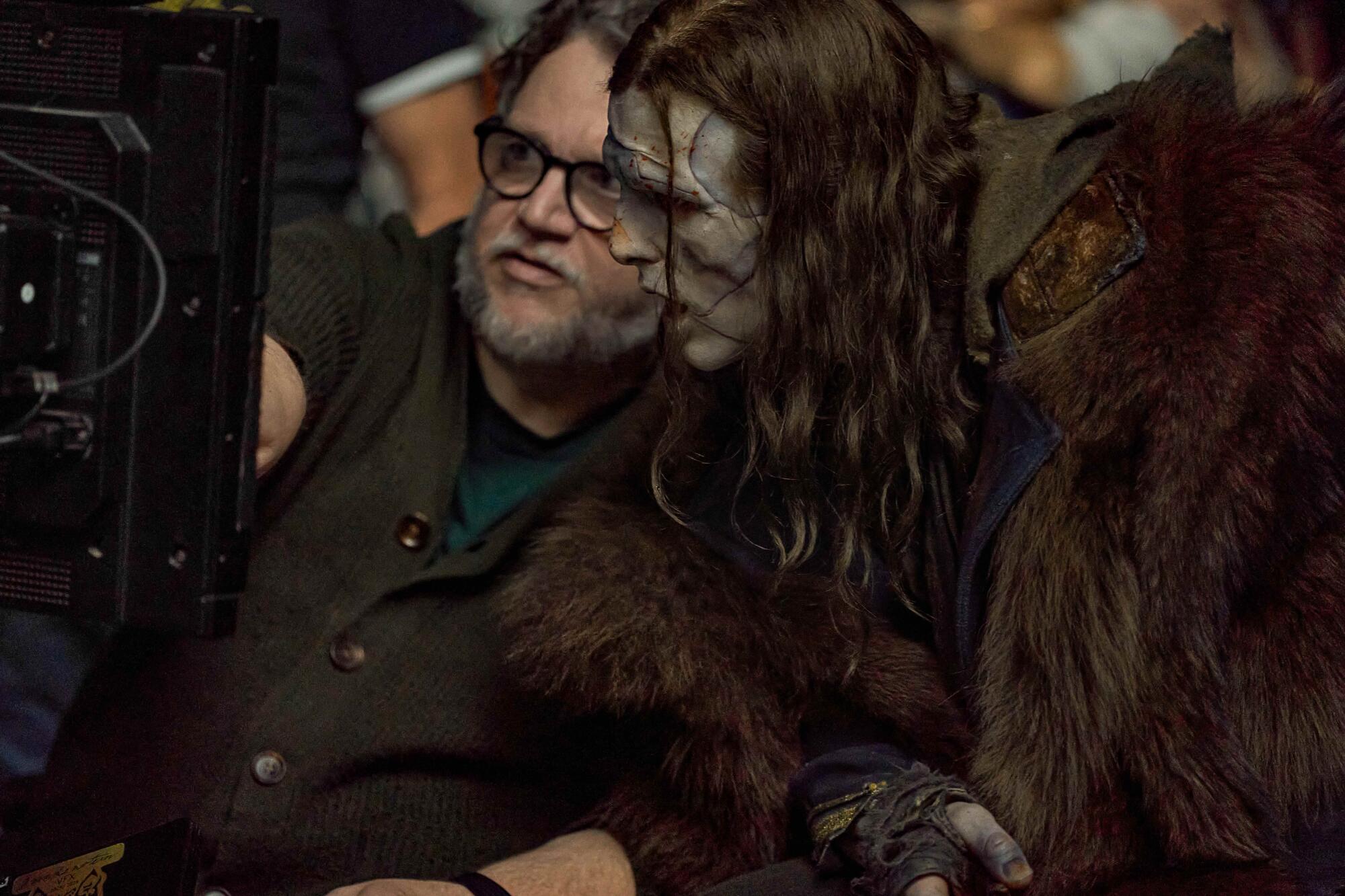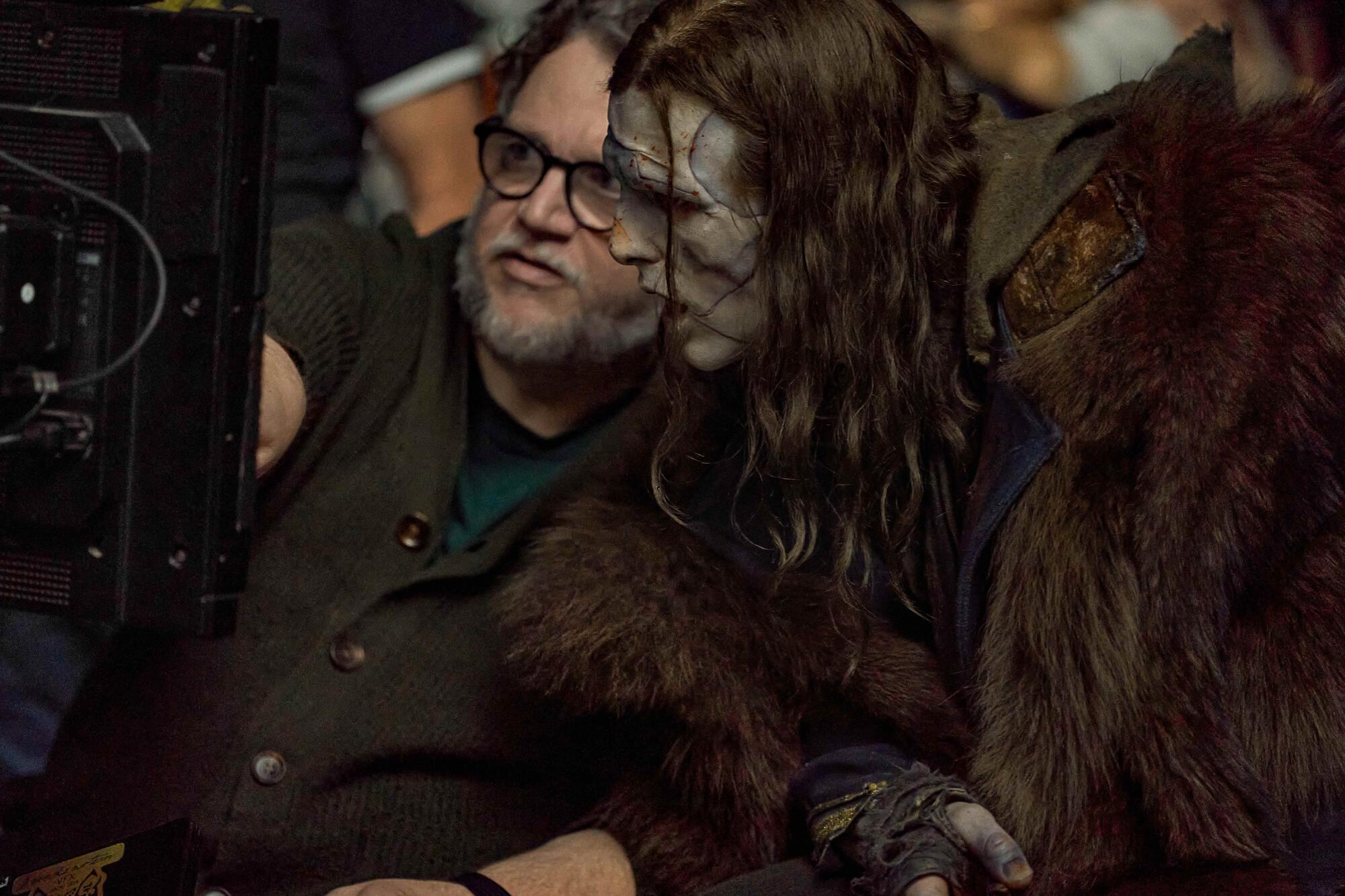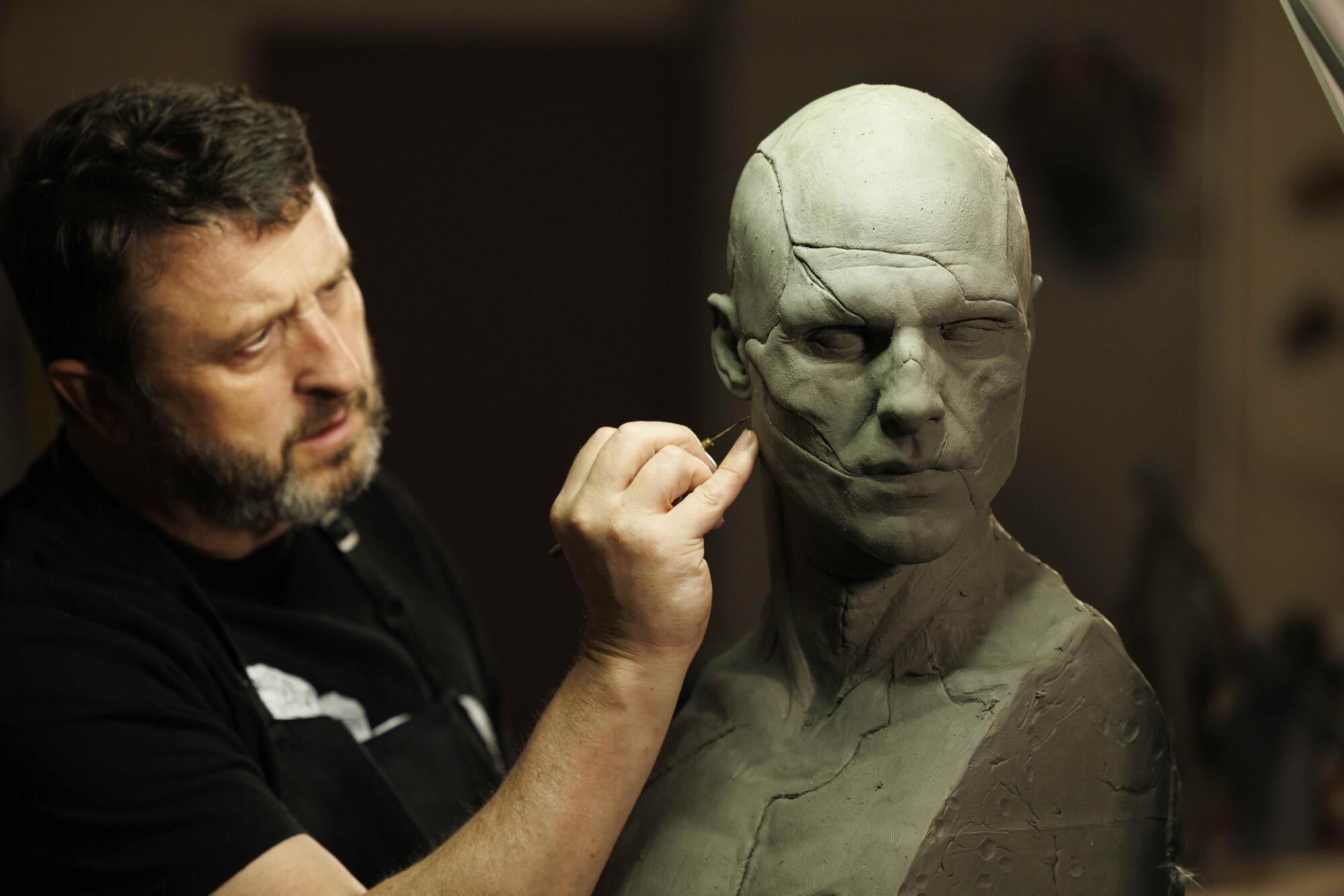‘Frankenstein’ review: Oscar Isaac as an arrogant 1850s tech bro
“Frankenstein” has haunted Guillermo del Toro since he was a kid who barely reached the Creature’s knees. Back in 2011, the writer-director was already tinkering with a version of the monster that resembled a blend of Iggy Pop and Boris Karloff with jagged sutures, gaunt wrinkles and a crushed nose. Since then, Del Toro has made changes. The 2025 model is played by Jacob Elordi, a 6-foot-5 actor often cast as the ideal human specimen in movies like “Saltburn” and who here howls to life with handsome features and rock star swagger. But your eyes keep staring at his pale, smooth seams. He doesn’t look hand-stitched — he looks a little like a modern android.
Of course he does. The decades have given Del Toro time to think about what truly scares him. It’s not monsters. He loves all disfigured nasties, be they swamp creatures, eyeball-less ogres or bolt-headed Hellboys. It’s tech bros, like the ones weaseling into Hollywood, who give their every innovation a sterile sheen.
“Frankenstein” is the director’s lifelong passion project: He doesn’t just want to make a “Frankenstein” but the “Frankenstein,” so he’s faithfully set his adaptation in the past. But he’s adjusted the wiring so that 1850s Europe reminds us of Silicon Valley. The result is the best movie of his career.
This Baron Victor Frankenstein (Oscar Isaac) is a short-sighted egomaniac who barks over his critics while jabbing the air with his fingers. “I fail to see why modesty is considered a virtue,” he says with a snort.
And Del Toro has written Victor an enabler: a deep-pocketed investor named Henrich Harlander (Christoph Waltz) who struts into Victor’s science lecture hunting for a whizkid to crack the code to immortality. With his gold-heeled shoes and a confidence that he’s too rich to die, Waltz’s wealthy arms dealer is a 19th century take on venture capitalists like Bryan Johnson and Peter Thiel who’ve been poking into the feasibility of pumping their veins with young blood.
“Don’t be a reasonable man,” Henrich advises Victor. The assumption is — and remains — that tycoons and geniuses deserve to run rampant. Great success demands an indifference to the rules. And if you’re wondering whether money or brains has more power, there’s a scene in which Henrich uses a chamber pot and smugly orders Victor to “flush that for me.”
Del Toro is wired into the outrage in Mary Shelley’s sly 1818 novel, a nightmarish satire about men who care only about yelling “first!” without asking what horrors come next. Centuries ago, she warned of man’s ill-considered rush to create artificial intelligence. Today, Dr. Frankenstein’s descendants keep promising that AI won’t destroy civilization while ignoring Shelley’s point, that the inventor is more dangerous than his monster.
Victor, a stunted man-child who drinks milk served by a sommelier, is frozen in the I’ll-show-him stage of growing up with an abusive father (Charles Dance) who whipped him when he got a wrong answer on his schoolwork. Victor’s name, we’re reminded, means “winner,” a symbol of the pressure he’s under to excel.
Isaac plays him with a pitchman’s exuberance that sags as the corners of his mouth wrench down in disappointment. He’s hacked how to make a disembodied head moan in agony. But having rarely felt affection, Victor doesn’t know how to generate that emotion at all. Worse, it hasn’t occurred to him to think past the triumph of his product launch, that his Creature can’t be readily unplugged. The only kind characters in the movie are a rural blind man (David Bradley) and the moth-like Mia Goth, double-cast as Victor’s mother, Claire, and his brother’s fiancee, Elizabeth. A convent girl with a creepy streak, Elizabeth sees beauty in biology, leaning over a corpse’s flayed back to appreciate the intricacy of its ventricles. But the more she studies Victor, the less impressed she gets.
Because Shelley came up with “Frankenstein” as an 18-year-old newlywed who’d just lost a baby, her message gets boiled down to gender: Women birth life, men mimic it. Really, the feminine strength of the book lies in its foxy, shifting narration that opens with a prologue from an Arctic explorer who’s gotten his sailors trapped in the ice, before transitioning to Victor’s story and then the Creature’s. Like a hostess who secretly loathes her guests, Shelley encourages her characters to flatter themselves and expose their braggadocio.
Del Toro has kept that tactic and he’s kept the book’s structure. But within that framework, he’s changed nearly everything else to make Victor more culpable. Unlike the 1931 film, there’s no Igor and no excuse of accidentally using the wrong brain. This Victor does his own dirty work and what goes wrong is his fault. Meanwhile, Del Toro amps up the action, starting the film off with a ghastly great sequence in which Elordi’s Creature punches a sailor so hard his spine snaps into a backward somersault.
“What manner of devil made him?” the Captain (Lars Mikkelsen) exclaims. Victor guiltily explains why he played God.
Being a futurist isn’t bad. Henrich, an early adopter of daguerreotype cameras, shoots photographs of women posing with skulls like he’s paving the way for Del Toro’s whole filmography. But pompous Henrich and Victor don’t appreciate that their accomplishments are built on other’s sacrifices. When the cinematographer Dan Laustsen pans across a battlefield of dead soldiers, it feels like a silent scream. Henrich made his fortune killing these men; now, Victor will salvage their body parts.
Del Toro delights in the kinetic gusto of the tale, the grotesquerie of cracking limbs and blood sloshing about Victor’s shoes. In the laboratory, dead leaves and buzzing flies whirl through the air as if to keep up with the inventor’s wild ambitions and Alexandre Desplat’s swirling orchestral score. The production design by Tamara Deverell is superb as are the costumes by Kate Hawley, who shrouds Goth in dramatic chiffon layers and dresses laced to highlight her vertebrae. (This movie loves bones as much as Sir Mix-A-Lot loved backs.)
As Victor rudely flings around torsos and limbs, it’s clear that he only values life if it’s branded with his name. So yes, of course, Elordi’s Creature looks good. He’s been assembled from the choicest bits of man flesh to show off the talent of his creator, not so different from Steve Jobs caressing samples of brushed aluminum. When Elordi’s Creature pleads for a companion, a sliver of sculpted abs peeking out from under five hulking layers of wool and fur, you expect half the audience’s hands to shoot up and volunteer.
Elordi has adopted one or two of Karloff’s mannerisms: the arms outstretched in search of warmth, the lurching walk. You can see that he’s a tad lopsided on the left side, presumably because Victor couldn’t find matching femurs. Mostly, he’s his own monster, neither the calculating serial murderer of the book nor Karloff’s reactive, animalistic killer, but a scapegoat who finally starts leveling his foes with bone-breaking efficiency.
Towering over Victor by almost a foot, Elordi’s Creature dwarfs his creator physically, morally and emotionally. There’s anguish in his eyes, and when Del Toro shows us the world through his perspective, humanity itself appears anti-life, a pestilence that destroys without hesitation.
There’s a pack of digital wolves that just looks silly. Otherwise, you trust how intensely Del Toro has doted upon every detail. I was flummoxed by a row of servants flanking young Victor (Christian Convery) who appeared to be wearing gauzy bags over their heads. What are those for? My theory is it’s a tribute to the veil Karloff sported during lunch breaks, so as not to frighten any pregnant secretaries on the Universal lot.
Eschewing mobs of pitchfork-wielding villagers, Del Toro focuses on Victor’s inability to parent his unholy son. And while the end stretch gets a bit too stiff and speechy, particularly with a line that Victor is the “true monster,” I loved the moment when the Creature, venting on behalf of all frustrated children however big they‘ve grown, growls, “The miracle is not that I should speak but that you would listen.”
This deservedly anticipated “Frankenstein” transforms that loneliness into stunning tableaux of Victor and his immortal Creature tethered together by their mutual self-loathing. One man’s heart never turned on. One can’t get his heart to turn off. Ours breaks.
‘Frankenstein’
Rated: R, for bloody violence and grisly images
Running time: 2 hours, 29 minutes
Playing: In limited release Friday, Oct. 17









